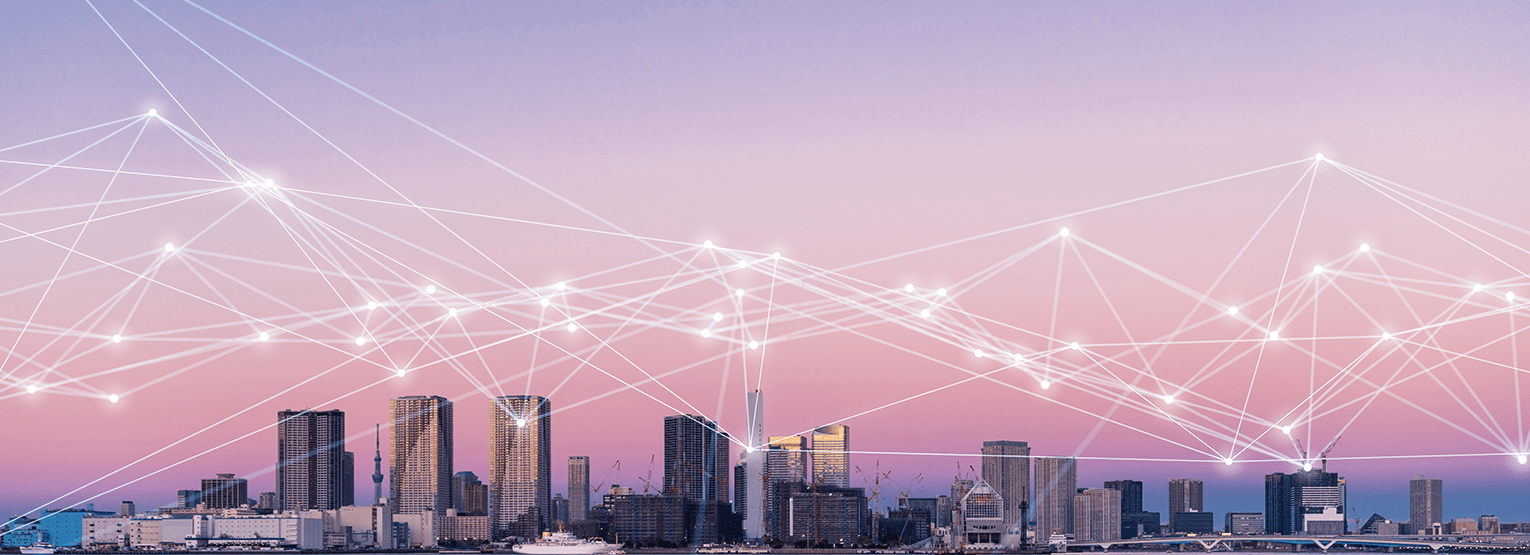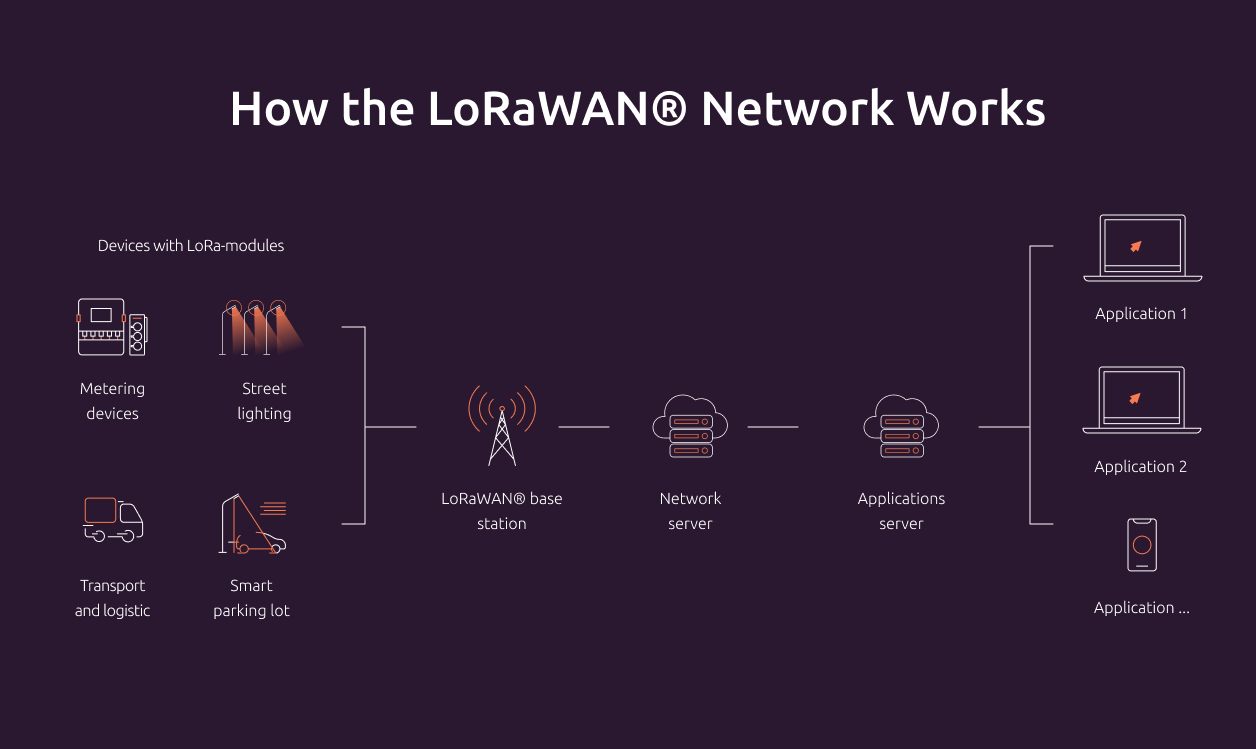Smart City - Blog - LoRa and LoRaWAN®: how to make your devices communicate with others
11.12.2020
 4965
4965

LoRa and LoRaWAN®: how to make your devices communicate with others

The internet enables people to communicate, tackle routine tasks, and even provide services remotely. However, few people know that there are internet technologies designed for devices to communicate between themselves. LoRa is one of them. It enables electronic devices to interact with each other without human assistance. Let’s dive in and see what LoRa and LoRaWAN® technologies are and how they are used.
LoRa is a radio signal modulation technology that enables data exchange in IoT (Internet of Things) networks. It can become a foundation for public, private, and hybrid networks. The technology provides broader coverage than cell networks. In networks like these, signals can travel up to 15 km while consuming very little energy.
A LoRa network needs a central server, a base station (gateway), and endpoint devices in order to work.
Endpoint devices monitor metering equipment and provide telemetry.
Base stations collect data from endpoint devices and transmit them to the central server.
The central server processes and stores the collected data, and it manages the base station and endpoint device operation.
The LoRa standard uses radio frequencies on the sub-gigahertz band:
Europe: 433 MHz, 868 MHz
Asia: 923 MHz
North America and Australia: 915 MHz
In most countries, these frequencies are license-free. Therefore, all you need is the equipment to set up a LoRa network.

The server contacts the base station through an IP channel, and the base station interacts with endpoint devices via radio waves with spread-spectrum modulation. Two-way communication is established between the endpoint devices and the base station. Generally, endpoint devices send data to the base station. One base station can receive data from thousands of endpoint devices.
LoRa networks have numerous applications in multiple fields. The technology enables the automation of management, monitoring, and control systems and it simplifies their operation:
Utility consumption metering. Smart meters automatically collect meter readings and send them to water, gas, heat, and electricity suppliers.
Street lighting. Smart lighting systems are controlled through IoT networks. With LoRa, operators can power the luminaires on or off, adjust their brightness, and monitor the status of each device.
Leak detectors. These devices detect gas and water leaks and alert infrastructure administrators about them.
Monitoring of environmental conditions. These devices regularly collect information about the air/water pollution and send reports to the system administrator.
Smart parking lots. LoRa sensors are integrated into the parking lot to detect if a parking spot is vacant and notify the system about it. Based on the data received, the system draws a parking lot map that is shown on the screen at the parking lot entrance.
Agriculture. Farmers use wireless sensors for real-time monitoring of the moisture level and chemical composition of the soil (the level of phosphate, nitrogen, sodium, etc.).
LoRa is how the radio signals are used on a material level, and LoRaWAN® is a data transfer protocol. It enables interaction between endpoint devices and the base station, management of signal frequency, and power, as well as, the data transfer speed. In other words, LoRa is akin to the human voice, and LoRaWAN®—to speech.
LoRaWAN® is used in low-power wide-area networks. In LoRaWAN® networks, signals can travel as far as 15 km in line-of-sight conditions.
With LoRa on the material level and LoRaWAN® as a data transfer protocol, the result is a high permeability of radio waves. With such a system, devices can send data even from hard-to-reach areas, e.g., underground and built-up areas.
LoRaWAN® is a low-power protocol used in battery-powered devices (sensors, remote data collection modules). These devices’ battery life may reach up to 15 years, with energy consumption depending on the data transfer intervals.
Long reach. The signal range may reach 10–15 km, which is more than other wireless technologies used in the systems for data collection and small-packet transmission can offer.
Power consumption. The transmission of small data packets requires little energy.
Permeability. Radio signals are transmitted on the sub-gigahertz band, enabling communication even in hard-to-reach areas.
License-free frequency band. No radio broadcasting license is required to deploy a LoRaWAN® network.
The Ukrainian IT company Infomir has used LoRaWAN® networks as the foundation for their Jooby Smart City projects. The technology is used to deploy smart lighting and remote data collection systems. LoRaWAN® networks enable Jooby Avenue system administrators to:
Jooby also launches comprehensive solutions for the remote collection of readings from water, gas, electricity, and heat meters using radio modules that send the data over a LoRaWAN® network.
The transceiver base station receives the radio modules’ signal and relays them to the server. Then the data can be accessed in the Jooby Dashboard app. The app compiles reports on utility consumption, meter and radio module status, the quality of the connection between the devices, and their battery level. The data can be exported into the CSV format for processing in external software, e.g., Microsoft Excel.
The admin dashboard can create general and personal utility consumption reports and alerts the operator about unsanctioned removal of the modules, disconnection of devices, magnet tampering, and low battery charge. The app can be accessed from a PC.
Jooby solutions can be deployed in third-party IoT networks or a private LoRaWAN® network. And any company can the same with minimum investments because the frequency band is license-free.
The Jooby team was one of the first to use LoRaWAN® technology in Ukraine. Infomir helps with radio module installation, LoRaWAN® base station configuration, and connection to an IoT operator.
LoRa networks enable long-distance interaction between electronic devices, ensuring high energy efficiency. The devices in such networks can work for years without replacing the battery. The technology tackles a multitude of challenges: from minor everyday interactions to the creation of smart industrial cities.
Stay on top of the latest industry news
Thank you, we have received your message. Our manager will contact you shortly.
Our experts are always happy to help and promptly answer your questions. Please fill out the form to discuss your project and develop a tailored action plan.
Thank you, we have received your message. Our manager will contact you shortly.
Thank you, we have accepted your request. In the near future the responsible manager will contact you and clarify the details of the order.
Our experts are always happy to help and promptly answer your questions. Please fill out the form to discuss your project and develop a tailored action plan.
Thank you, we have received your message. Our manager will contact you shortly.